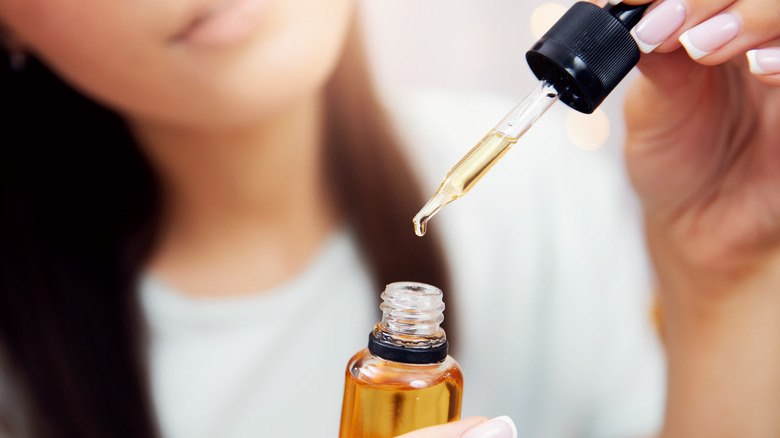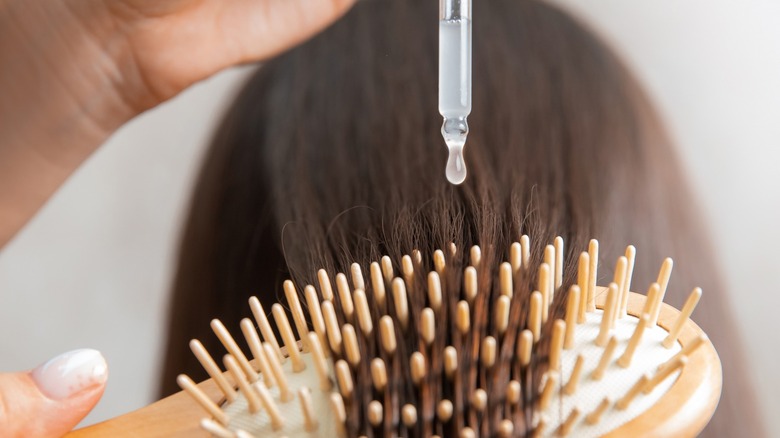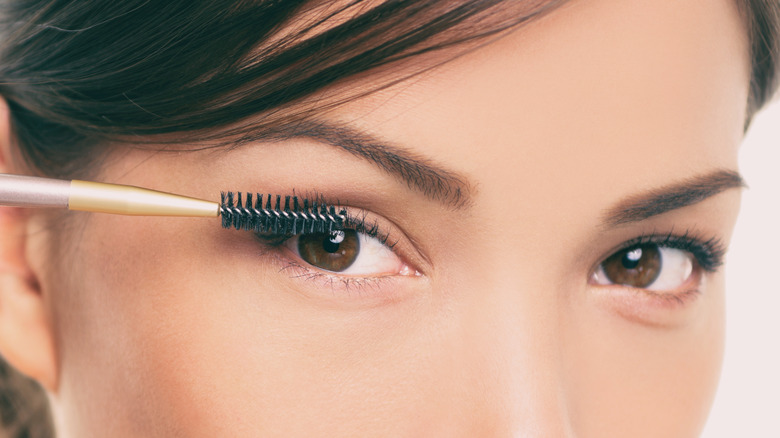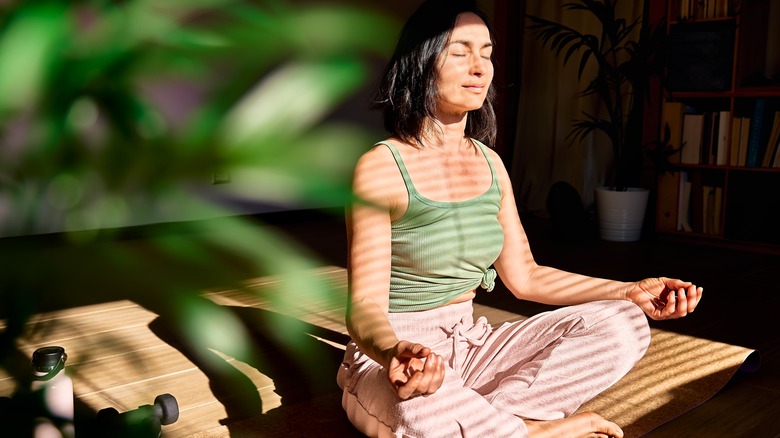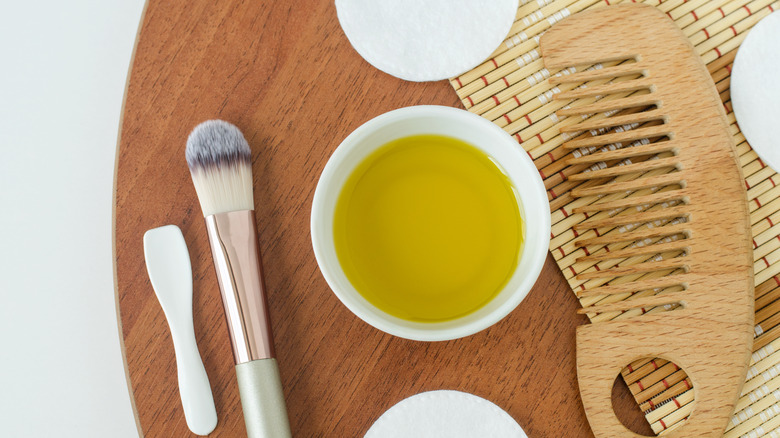Castor Oil 101: The Benefits, The Risks, & Exactly How To Use It
You might have heard about castor oil, but do you know how to use it? Since ancient times, it's been relied on as a beauty treatment dating back to ancient Egypt, and it's even said that Cleopatra used castor oil in some of her beauty treatments. Besides healthy fatty acids and antioxidants, it also has anti-inflammatory and stimulating effects, according to WebMD. Castor oil can be a simple solution to many minor beauty issues and may help support health, too. Not only can you find castor oil sold on its own, but it's also a popular ingredient in things like lotion and shampoo.
Initially, castor oil may not seem easy to use. This thick and gooey substance could seem hard to manage, and you may wonder how to use it safely. The good news is that using castor oil can be simple, and there are many ways to take advantage of this multi-use beauty treatment that boasts health benefits, too. So, whether you want to even out your skin tone or get help with hormonal issues, castor oil may provide the support you need. By learning how to use castor oil, you can feel comfortable with its many applications and get the most out of this natural, versatile powerhouse.
Castor oil basics
Native to Africa and Asia, most of the castor oil currently available is sourced from India (per Healthline). This vegetable oil is derived from the castor plant seed and is odorless. Being both stimulating and soothing, it contains vitamin E and high levels of fatty acids omega-3 and omega-6. It is also high in antioxidants, which can help prevent cell damage, and its levels of ricinoleic acid make it a natural humectant, which means it's great for retaining moisture.
Castor oil can be found in different forms, and the type that you need depends on what you're using it for. If taking it internally, pill form may be best for you, or if you intend to use it primarily for beauty treatments, Jamaican black castor oil, which has a different extraction process, could be more efficient than standard castor oil (per beauty brand Anveya). Castor oil typically comes in a bottle, sometimes with a dropper. It can also be found in roll-on form so that it can be applied directly to the skin.
Grow healthier hair
Whether you want to heal your scalp or start growing stronger, shinier, and healthier hair, castor oil can provide support. It can moisturize a dry scalp, which can be super helpful for those with dandruff. It can also be great for smoothing frizzy hair or split ends, detangling hair, and preventing hair matting.
The fatty acids it contains help the oil penetrate hair deeply, which means increased moisture and strength. Because it has stimulating properties and can help increase blood flow to the scalp, castor oil can help with hair stimulating hair growth. More blood flow can mean more nutrients flowing to your scalp and faster-growing hair. Also, its anti-bacterial properties can help heal scalp conditions like psoriasis, which can lead to hair loss.
If targeting the scalp, start applying castor oil either to your scalp or fingertips and begin massaging it in. If you are soothing split ends, wellness brand Dr. Axe recommends beginning by massaging into the ends of your hair and working up. Sectioning your hair off can make for a more even application. For the best results, castor oil should be left on for a minimum of 30 minutes. If you want serious benefits, you can tuck your hair into a shower cap and leave it on overnight. Castor oil treatments for hair can also be combined with other soothing oils, like essential oils, vitamin E oil, and coconut oil. Afterward, shampoo and condition your hair as you normally would.
Lengthen your eyelashes
Just like your hair, castor oil can help lengthen your eyelashes, too. Even though some claim that there aren't many proven benefits of using castor oil on your eyelashes, others claim that it can help strengthen and condition them (just like it does for the rest of your hair), which can equal thicker, softer, and longer eyelashes. Also, it isn't just your eyelashes that can benefit from castor oil. If you have sparse eyebrows, swiping a little castor oil can be great for them, too.
A clean spoolie brush makes a great tool for applying castor oil to eyelashes and eyebrows, as does a cotton swab. Even though castor oil is a natural substance and is generally considered safe, it can cause eye irritation, so careful application is important. If you get castor oil in your eyes, flush them out with water immediately. After a shower or during your nighttime beauty routine can be a great time to apply castor oil. With regular application, it can take a few months to notice results.
Fight acne
Even though it may seem counter-intuitive to add more oil to your skin when it is already oily, castor oil has skincare benefits, and it can go a long way toward banishing acne. Because castor oil has anti-bacterial properties, it can fight the bacteria that cause acne and blackheads to form. Its anti-inflammatory properties also help reduce the redness and inflammation caused by acne, too. That said, castor oil may not be great for everyone. If you already have very sensitive skin, it could cause irritation.
How long you leave castor oil on depends on your overall skin type. If your skin is very oily, you may only want to leave it on for a few hours. If you have drier skin, leaving castor oil on for the rest of the day or overnight may help moisturize your skin as it battles acne. Using a carrier oil, such as almond oil or coconut oil is also ideal when using castor oil on your skin. A carrier oil can help dilute castor oil and ensure it's not too harsh on your face.
Reduce wrinkles and dryness
If your skin is dry, castor oil's natural moisturizing properties could be the solution for you. Because it contains vitamin E and is packed with fatty acids, it can bring much-needed moisture to the skin. It also has nourishing properties, which can be great for reducing and preventing wrinkles and evening out your skin tone. Stearic acid, ricinoleic acid, oleic acid, and linolic acid make up some of the powerful fatty acids that make castor oil so beneficial for the skin. Ricineolic acid is a humectant, which means it softens skin and aids in moisture retention. It's also chock-full of antioxidants, which help with cell rejuvenation and preventing cell damage. This means it can help keep your skin looking young and refreshed and put a damper on signs of aging.
Because castor oil can be thick and sticky, it is often best to use it on your skin with a carrier oil. Mixing a teaspoon of castor oil with a teaspoon of olive oil, jojoba oil, or grapeseed oil can make a good consistency. Next, apply it to your skin, massaging it in. Leave this mixture on for 15 to 20 minutes before rinsing off.
Nix your skin irritation
Acne and wrinkles aren't the only things that can be helped by castor oil and its anti-inflammatory, anti-fungal, anti-histamine, and anti-bacterial effects. A damaged skin barrier, ringworm, insect bites, athlete's foot, cracked heels, eczema, sunburn, sun damage, dry cuticles, wounds, infections, and puffiness can all be helped by castor oil, according to WebMD. Dark under-eye circles and eye bags can be battled with castor oil, as can chapped, dry, or cracked lips. All of these benefits are due in large part to the high antioxidant content and fatty acids, as well as the fact that it's a natural humectant.
When using castor oil on your skin, it may be best to do a test patch before applying it all over your face. Redness, itching, and burning can all be signs of an allergic reaction. Just like when you use castor oil for acne or wrinkles, it is beneficial to use a carrier oil.
Get help healing your liver
Liver support is another reason why castor oil can be great to have on hand. This is true if you struggle with issues like fatty liver disease or if you're trying to detox your liver. Because your liver is responsible for detoxing and processing your hormones and everything you consume, it can be easy for it to get overwhelmed. Some signs that your liver needs help are skin issues and irritation, hormones that are out of whack, constipation, and fatigue.
Along with eating a liver-supporting diet and getting enough exercise, castor oil can be great for helping support your liver. The most common way to use castor oil for your liver is a castor oil pack, which is a piece of cloth soaked in castor oil and then placed on the area you wish to target. When you use a castor oil pack over your liver area, it can help stimulate blood and lymphatic flow, as well as remove toxins from your tissues, according to Hashimoto's advocate Phoebe Lapine. Castor oil packs for liver healing should be done at least once a week for a minimum of 30 minutes (per Women's Health Network).
Support fertility and manage PCOS
Whether you're dealing with bad menstrual cramps, irregular periods, or ovarian cysts, castor oil could help you manage it. Because castor oil helps increase blood flow, it can help with different kinds of stagnation and congestion, which are issues that are often present when dealing with PCOS and other fertility-related issues, according to Yinstill Reproductive Wellness. The fact that castor oil increases circulation and boosts lymphatic drainage means that it can help remove toxins, which also often equates to reduced inflammation. This can help with cysts, fibroids, enlarged follicles, and pain from menstrual cramps.
When using castor oil for fertility-related issues, you'll need to use a castor oil pack. You can use it as often or as little as you'd like, for at least 30 minutes at a time. Some may only need to use it occasionally (like when having cramps), while others may want to use treatments a few times a week for optimal results shares Dr. Kathleen Mahannah, N.D.
Use it for postpartum support
Castor oil can be great to use for postpartum support for multiple reasons. If you are struggling with mastitis, applying castor oil to your breast can help heal the infection, according to Beyond Birth Collective. Mastitis sometimes occurs when milk isn't being emptied adequately or frequently enough and can cause swelling, pain, and tenderness. Using a castor oil pack on the breast for 30 minutes at a time is ideal. Careful cleanup afterward is also important, so your baby does not ingest any castor oil the next time they breastfeed. Castor oil can also stain your clothing, so wearing something you don't mind getting stained is best.
Because of its powerful wound-healing abilities, castor oil can also be great for healing a C-section scar. Typically, it can take about six weeks for a C-section scar to heal, but that doesn't mean you can't try natural remedies to help speed up the process. Castor oil should be applied topically to the scarred area. Besides helping with healing in general, castor oil can help reduce the pain you feel in the area, too.
Improve your digestion
Castor oil is well known for its laxative properties. Considered a natural stimulant laxative, it causes the bowels and the muscles surrounding them to contract. This movement of the bowels is what helps keep things passing through, and improves digestion. Because it stimulates blood flow and detoxifies, it can also help reduce bloating.
While castor oil can provide great digestive support, it's important to limit how much you use it as a laxative. The more you use it, the more your bowels may begin to rely on it and the less they may contract naturally on their own, which could end up worsening constipation issues in the long run. Something else to be aware of is that it may cause diarrhea for some.
When using castor oil for digestion, you'll need to take it orally. You can consume the oil by itself or with juice or water to lessen the taste. Castor oil is also available in pill form. How much you take can depend on different factors like your age and the severity of your issue. It can take between 2 to 6 hours for castor oil to begin working, according to Medical News Today. Because it starts working quickly, it's generally best to take castor oil for constipation relief during the day.
Relax your nervous system
One reason why castor oil can help you relax is that its detoxifying powers can help aid in balancing hormones, which could impact your mood. This can be especially helpful for those with mood swings related to hormonal imbalances. Castor oil may also help foster feelings of relaxation because it can stimulate the parasympathetic nervous system. This part of the nervous system helps your body relax after experiencing stress and is sometimes called the rest and digest part of the nervous system. It is the opposite of the sympathetic nervous system, which is part of the nervous system related to being in flight or fight mode.
Stimulating your parasympathetic nervous system can help you manage anxiety and insomnia, as well as general feelings of stress, according to Dr. Abigail Seaver, N.D. When using castor oil to relax, a castor oil pack on the abdomen is the best way to go. Spending 45 minutes to an hour with it on can be optimal for relaxation, as is doing a calming activity, like meditating, at the same time.
Boost immune function and circulation
If your immune system needs a boost, castor oil can help with that, too. The key behind castor oil's immune and circulation-boosting abilities is that it helps improve lymphatic flow (per WebMD). Lymph nodes are located all over your body and are connected through lymph vessels. They help drain out cellular waste and protect you from bacteria and illnesses. If your lymphatic flow is sluggish, you're more likely to feel tired and have a lowered immune system. When your lymphatic system is draining properly, you will have more energy and a stronger immune system overall. Along with stimulating your lymph nodes, castor oil also helps stimulate blood flow, which is another plus for your immune system. The more oxygenated blood you have circulating, the better you're likely to feel.
A castor oil pack on the abdomen is the best way to use the oil for immune function. How often or little you use a castor oil pack is up to you, but it may be best to use the castor oil pack for at least 45 minutes, preferably with your feet elevated says the Integrative Naturopathic Medical Centre. These packs should ideally be used lying down and with a heating pad, but they can be adapted to be used on the go if you don't have the time to relax while using them.
How to use castor oil
When using castor oil, quality is important. Organic options are usually best, and selecting castor oil that is hexane-free is also important. One of the most common ways to use castor oil is with a castor oil pack.
Besides the oil, you'll need a large piece of unbleached wool or cotton flannel, saran wrap, an old towel, and a hot water bottle to make a castor oil pack. First, saturate the fabric with castor oil. Next, place the fabric on the part of your body you're targeting. You can then cover the castor oil with saran wrap or a plastic bag. Next, lay on your old towel and place your hot water bottle on your castor oil pack. A rice sock or heating pad can be good options, too.
How long you leave your castor oil pack on is up to you, but because castor oil is thick, it will need heat as well as time to work its best. Aiming for somewhere between 20 to 60 minutes (or longer) is ideal. You can also adapt your pack to be mobile by using saran wrap to wrap the saturated cloth around your body and forgoing a heating pad, although you may need to use it for a longer period of time to get good results. Once you are done, wash and dry the area where the castor oil was. The saturated fabric can then be stored in the fridge and used again, according to Healthline.
Side effects and other things to consider
Even though castor oil has tons of health and beauty benefits, you may need to exercise some caution when using it. This is especially true for pregnant people since it can cause uterine contractions, which can induce labor (per Healthline). Castor oil can interact with some drugs, like heart medications, blood thinners, and some antibiotics, to name a few. For children under 12, it may be best to talk to a doctor before using. Those over 60 may also need to exercise caution regarding internal castor oil use, as do those with bowel obstructions or other bowel issues as using it internally too frequently could worsen bowel issues.
Other potential side effects from using castor oil internally include abdominal cramping and diarrhea, dizziness, low blood pressure, nausea, and electrolyte disturbances, according to RxList. When used topically it can lead to redness, itching, and burning so using caution before you know for sure how it will affect you is important. If you feel uncertain about using castor oil for any reason, talking with your doctor may be beneficial. Despite some potential side effects, castor oil is generally considered a safe and natural substance for most to use. By learning how to use it, you can tap into an ancient solution for a whole host of health and beauty needs.
